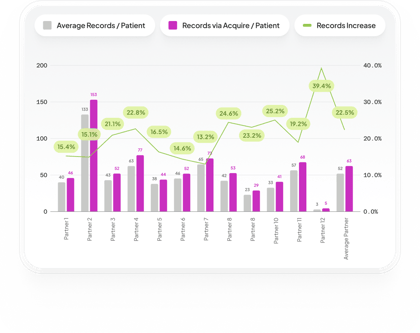We Were Promised Interoperability. Patients Are Still Waiting.

By Carm Huntress, CEO, Credo Health
In October, we announced Care Map, a major enhancement to our AI-powered medical record retrieval agent. Our Care Map capability builds a near-perfect patient history by discovering where a patient has received care, verifying those sites, and retrieving the underlying records.

Why Now
For years, the U.S. has invested in interoperability frameworks and task forces. We have had pledges, principles, and panels. And yet, in 2025, physicians and care teams still spend an astonishing amount of time manually chasing patient records because the data they need does not reliably show up when and where care happens.
At a July 2025 White House event, national leaders called for faster, patient-centered data sharing through TEFCA pathways and existing national networks—underscoring how critical access is to safety, equity, and cost.
More than half of Medicare beneficiaries—about 34.1 million people—are now enrolled in Medicare Advantage, and over 53% of people in Traditional Medicare are in accountable-care relationships; together with Medicaid managed care, that means tens of millions of Americans receive care in value-based arrangements where complete histories matter.
Our own surveys echo what we hear every day: staff devote 20 to 40 percent of their time to manual retrieval and pre-visit chart prep, with copy and processing fees that can reach $150 to $250 per chart.
That is not a workflow problem. It is a systemic failure.
Why Manual Chase Persisted
Three hard problems kept teams stuck in the past:
- Finding all the places a patient received care. It is not one hospital or one EHR anymore; it is a mosaic of specialists, labs, imaging centers, and community sites. Patients also change coverage frequently, which scatters records across plans and states.
- Plan churn and claims are not enough. Medicare beneficiaries often have histories that span prior employer plans and regional payers in other states after retirement. For many on Medicaid, coverage can be intermittent as people move to employer-based or individual plans, further fragmenting the trail of records. Claims alone rarely reveal the full clinical picture. (Medicaid and CHIP enrollment was ~77.7 million in June 2025, much of it in managed care.)
- Retrieving the complete record set. Even with strong national networks, 30 to 50 percent of high-value clinical data often sits outside purely digital pipes.
So organizations hired more staff, sent more faxes, and accepted the drag on outcomes and cost.
 What Changed? We Did the Work
What Changed? We Did the Work
At Credo, we decided to solve all three problems end to end.
Care Map uses AI to map where each patient has actually been seen, then digitally retrieves records via our certified on-ramp to Carequality and national networks such as CommonWell and eHealth Exchange, plus regional HIEs. That alone improves speed and c
overage.
For the 30 to 50 percent of high-value encounters that do not return digitally, we chase them systematically. Our agent-assisted workflows contact source providers by phone, portal, or fax and bring the remainder in. The result is a comprehensive, source-cited medical history at scale, available for the visit instead of weeks later. In live deployments, Care Map delivers a 30 to 50 percent increase in chart retrieval compared with digital-only approaches.
Security, Privacy, and Provenance
We transact through established networks, maintain rigorous controls, and preserve audit-ready provenance with every record we deliver. Security and access are not in conflict. Done right, they reinforce each other.
Patients Are Already Voting With Their Feet
Even when our ads target clinicians, patients find us and ask for help getting their records. That demand is real: people want their data where their care happens. America should not need Credo Health to make that a reality. But today, it does.
Why This Matters Now
- Better outcomes, fewer misses. Complete, longitudinal histories reduce misdiagnoses and support safer treatment.
- Less waste. Replace 20 to 40 percent staff time spent on manual chase; avoid $150 to $250 per-chart fees; deliver charts in days, not weeks.
- Risk integrity under VBC. Complete upstream data powers our physician-trained AI to surface cited insights, close gaps, and document with confidence at a commodity cost.
A Practical Path Forward
Interoperability is not a press release. It is a working, complete, source-cited record in a clinician’s hands before the patient sits down. Care Map proves we do not have to wait for perfect policy or universal behavior change. We can connect to the networks that exist, find the rest, and deliver a near-perfect patient history now, supporting more accurate diagnosis and richer care insights without adding cost.
If you are ready to trade fax machines and follow-ups for complete, in-visit histories at a fraction of today’s costs, we are ready to help.
See How Credo Works





